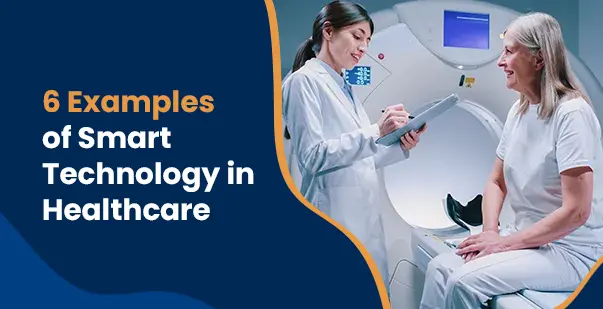6 Examples of Smart Technology in Healthcare

July 24, 2025
Introduction
Have you ever considered how much technology has changed healthcare? Advances in technology have improved the way we receive and deliver care in the past few decades. According to a report, over 75% of hospitals now use telemedicine to connect patients and doctors remotely. From virtual doctor visits to robotic surgeries, modern technology makes healthcare faster, safer, and more accessible.
Medical innovations and smart technology in healthcare empower patients to take more control over their health. In this blog, we’ll explore some of the most exciting technological advancements in healthcare.
Why is Smart Technology Important in Healthcare?
Before reviewing the examples of smart technology in healthcare, let us see why it is important. Smart technology is making healthcare faster, safer, and more patient-friendly. It allows doctors and patients to work together more effectively and ensures more accurate treatment. Smart technology in healthcare offers:
- Improved Efficiency: By automating routine tasks and monitoring, healthcare providers can focus more on complex patient needs.
- Enhanced Precision: Technology-driven diagnostics and treatments minimize human error.
- Patient Empowerment: Patients can take an active role in managing their health, tracking symptoms, and maintaining well-being.
Also Read: Is Google Voice HIPAA Compliant?
Examples of Smart Healthcare
Smart healthcare technology is transforming the way we receive and deliver medical care. From remote consultations to high-tech surgical tools, these innovations are making healthcare more accessible, efficient, and personalized. Below are examples of technology in healthcare:
-
Telemedicine
Telemedicine marks a revolution in health care by enabling patients to connect with doctors from any remote location. This simply means that you do not have to visit the clinic or hospital in person to seek consultation with a healthcare professional.
Doctors can diagnose and treat patients remotely through video calls, phone calls, and instant messaging apps.
Benefits
Telemedicine offers greater accessibility, allowing people in remote or underserved areas to access quality healthcare without the need for long-distance travel. It’s a convenient solution for patients with busy schedules or mobility challenges, saving time and avoiding long waits. Additionally, it reduces exposure to infections, as seen during COVID-19, by minimizing the need for in-person visits.
Telemedicine goes beyond general consultations. It’s widely used for ongoing care, such as monitoring chronic diseases (e.g., diabetes), mental health counseling, and even post-surgery follow-ups, where doctors can assess the recovery progress.
Steps to Use
With each new technology comes challenges to utilize it with great potential. Patients can follow these steps to use telemedicine for their comfort and ease:
- Patients start by booking an appointment online through a telemedicine platform.
- At the scheduled time, they log into the platform and connect with their doctor via a secure video call.
- Just like in a regular in-person visit, the doctor can ask questions, discuss symptoms, and even observe physical signs.
- If necessary, the doctor can prescribe medication, recommend further tests, or schedule a follow-up visit.
-
Wearable Health Devices
Wearable health devices like smartwatches and fitness trackers have become a regular part of many people’s lives. Sensors collect various health metrics, such as heart rate, sleep patterns, physical activity, and even oxygen levels in the blood.
Benefits
Wearables allow users to monitor their health and take note of any unusual changes, making it easier to detect early signs of illness. Some devices are designed to detect emergencies, such as falls or abnormal heart rates, and send alerts to emergency contacts or doctors. These devices are particularly beneficial for people managing chronic conditions like diabetes or hypertension, as they provide continuous monitoring and support.
Steps to Use
Wearables have become a popular choice for tracking health and fitness metrics effortlessly. To use them effectively for tracking your vitals, do the following:
- Wearables, like watches, are typically worn on the wrist and are equipped with sensors to track physical activities.
- The device continuously monitors parameters like steps taken, calories burned, heart rate, and sleep quality.
- All the collected data is then synced to a mobile app, where users can view detailed reports, set fitness goals, and track their progress over time.
Some advanced wearables can even detect health issues early. For instance, they can monitor heart rhythms and detect irregularities like atrial fibrillation (AFib), which could indicate a risk of stroke. In such cases, the wearable may send an alert to the user or notify a healthcare professional.
-
Artificial Intelligence (AI) in Diagnosis and Treatment
Artificial Intelligence (AI) is revolutionizing healthcare by making diagnoses more accurate and treatment plans more personalized. AI-powered systems can quickly analyze large amounts of data from patient records, lab results, and medical images to help doctors make better decisions.
Benefits
AI can spot subtle changes in imaging scans or lab results that might be overlooked, leading to more accurate and early diagnoses. It can assess how different patients respond to various treatments, allowing doctors to tailor therapies based on individual needs. It will help automate routine tasks like appointment scheduling, data entry, and even initial patient assessment, freeing up more time for healthcare professionals to focus on patient care.
Steps to Use
AI analyzes vast amounts of information and provides faster and more accurate insights to support clinical decisions. To utilize the full potential of AI for diagnosing diseases, consider the following points:
- AI algorithms are developed using extensive datasets of patient health records, which include a wide range of medical histories, symptoms, and outcomes.
- After training, the AI can identify patterns and correlations that may not be apparent to the human eye. For example, AI can scan an X-ray or MRI and highlight potential areas of concern, which can help doctors detect conditions like tumors or fractures early on.
-
Electronic Health Records (EHRs)
Electronic Health Records (EHRs) are digital versions of a patient’s complete medical history. They include information such as diagnoses, medications, treatment plans, immunization records, allergies, and lab results.
By transitioning from paper-based records to EHRs, healthcare providers can easily access and update patient information, which leads to more coordinated and effective care.
Benefits
EHRs allow doctors to access a patient’s complete medical history instantly, even if the patient was treated at different facilities. This reduces the chances of medical errors, as doctors can see previous treatments, test results, and allergies.
Multiple healthcare providers can view the same patient records, ensuring everyone involved in the patient’s care is on the same page. This is especially important for patients with chronic conditions who see multiple specialists.
EHRs also include automated alerts for potential drug interactions, allergies, or abnormal lab results. This helps prevent harmful side effects or medication errors, enhancing patient safety.
Steps to Use
EHRs are designed to streamline the documentation and sharing of health information. To use them to access the health information of a patient, you should follow these steps:
- Healthcare providers, such as doctors and nurses, enter patient information into an EHR system during each visit or treatment session.
- The EHR system can securely share this information with other authorized healthcare providers, such as specialists or emergency care units.
- EHRs pull data from multiple sources, such as imaging centers and laboratory tests, to create a comprehensive and up-to-date patient profile.
- With EHRs, a patient’s health history is available in one place, ensuring that healthcare professionals have all the necessary information to make informed decisions.
-
Robotic Surgery
Robotic surgery involves the use of robotic systems to perform complex surgical procedures with high precision. Surgeons control robotic arms that can make tiny, accurate movements, minimizing the risk of errors.
Benefits
Robotic surgery often requires only small incisions, which means patients experience less pain, minimal scarring, and shorter recovery times compared to traditional open surgery. These robotic arms allow for microscale precision, reducing risks and improving surgical outcomes, which reduces the risk of errors and complications during surgery. The 3D camera provides a detailed view of the surgical area, enabling surgeons to see even the smallest structures.
Steps to Use
Robotic surgery uses technology to enhance surgical precision and control. Here are the steps involved in performing robotic surgery:
- During robotic surgery, the surgeon sits at a specialized console, often a few feet away from the patient.
- The surgeon directs the robotic arms, which hold surgical instruments and a high-definition camera, using hand and foot controls.
- The robotic arms can move in multiple directions and have a greater range of motion than human wrists, which allows them to access hard-to-reach areas in the body.
- The camera provides a magnified, 3D view of the surgical site, giving the surgeon a clearer picture and better visualization than traditional methods.
-
Smart Hospital Rooms
Smart hospital rooms use advanced technologies like IoT (Internet of Things), voice assistants, and automated systems to improve patient care and experience. These rooms are equipped with various devices that monitor patients’ conditions and allow them to control their environment with ease.
Benefits
Patients can easily control room settings, making their stay more comfortable and less dependent on nursing staff for simple adjustments. Continuous monitoring means healthcare providers are immediately alerted to any changes in the patient’s condition.
Automated systems handle routine tasks like adjusting room temperature or lighting based on the time of day, freeing hospital staff to focus more on patient care.
How They Work
Smart hospital rooms use advanced technology that can enhance patient care and comfort. To understand how they work:
- Sensors and devices placed around the room continuously collect data on the patient’s vital signs, such as heart rate, temperature, and oxygen levels.
- The data is analyzed in real-time, and any concerning changes are instantly reported to healthcare staff, ensuring quick response times.
- Patients can also interact with the room using voice commands or mobile apps. For example, they can adjust the lighting, temperature, or TV without getting out of bed.
- Advanced smart hospital rooms may include smart beds that adjust automatically to reduce pressure points and prevent bedsores. They may have digital whiteboards that display the patient’s treatment plans, schedules, and other important information. This helps patients and their families stay informed and engaged in the care process.
Read More: Patient-Centered Care: What Is It and Why It’s Important
Smart Technology for a Healthier Future!
Smart technology helps patients while enhancing patient experience and empowering healthcare professionals to provide better, faster, and more accurate care.
Innovations such as telemedicine, wearable health devices to monitor their health, artificial intelligence, and robotic surgery will be nothing short of minimal.
What more is yet to come as the technological world continues to evolve? For instance, AI could soon help doctors predict illnesses before they happen, or wearables may be more advanced, giving real-time alerts to serious conditions. As technology in healthcare improves, we are moving toward a world where quality medical care is available to everyone, no matter where they live.





